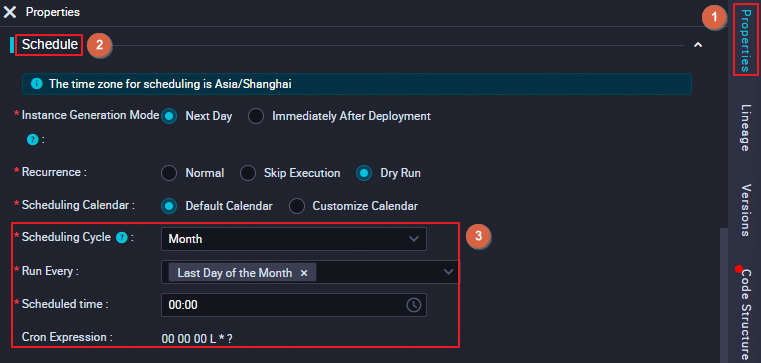If a node is scheduled by month, the node is automatically run at a specified point in time on specific days every month. For example, a node is scheduled to run on the first day and second day every month.
Precautions
To ensure that the descendant nodes of an auto triggered node that is scheduled by month can run as expected at a point in time that is not the scheduling time of the node, the system generates a dry-run instance for the node.
ImportantIf a node is dry run, the system does not actually run the node but directly prompts that the node is successfully run.
The running duration of the node is 0 second, and no run logs are generated for the node.
The node does not occupy scheduling resources.
The node does not block the running of its descendant nodes that are scheduled by minute, hour, or day.
You can configure a scheduling frequency only for a single node. Whether a node is scheduled to run every day depends on the scheduling frequency configured for the node and is unrelated to the scheduling frequencies of the ancestor nodes of the node. The scheduling time of the ancestor nodes of the node affects the actual time when the node is run.
You can set the Run Every parameter to Last Day of the Month. This way, the node is run on the last day of every month.
Configuration example
- Configuration method
On the DataStudio page, create a node and go to the configuration tab of the node. Click the Properties tab in the right-side navigation pane. In the General section of the Properties tab, configure the scheduling period for the node.
Scenario
Configuration details
If the node is scheduled to run on the last day of every month, the scheduling system runs the instances that are generated for the node on the last day of every month. The scheduling system generates dry-run instances for the node on each of the rest days of every month and directly returns a success response for the instances. The code of the instances are not run. The following figure shows the details about the configurations.
Note The cron expression is automatically generated based on the scheduling time that you select and cannot be changed.
Scheduling details
The scheduling system automatically generates and runs instances for the node.
 Important
ImportantIf you use the data backfill feature provided in Operation Center to backfill data for a node that is scheduled by month, you must make sure that the data timestamp you specify is one day before the date on which the node is scheduled to run in the current scheduling cycle. The data timestamp of a node is calculated based on the following formula: Date of the scheduling time of the node - 1.
Description:
If you want to backfill data for a node that is scheduled to run on the first day of every month, you must set the data timestamp to the last day of the previous month for the node.
If you want to backfill data for a node that is scheduled to run on the last day of every month, you must set the data timestamp to the previous day of the last day of the current month for the node.
If you set the data timestamp to a date that is not one day before the date on which a node is scheduled to run, the data backfill instance generated for the node will be dry run.